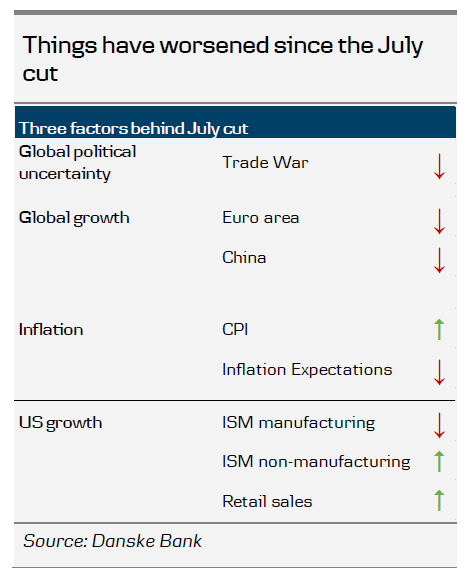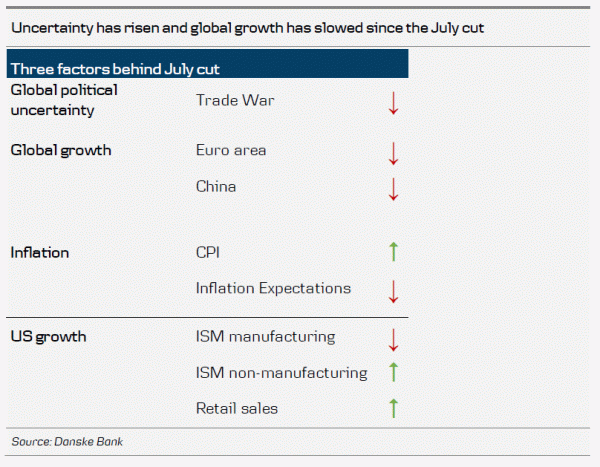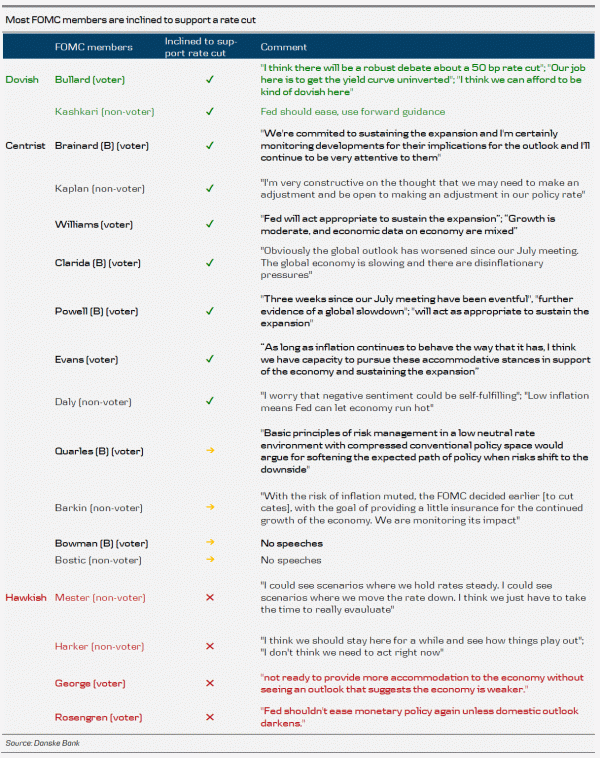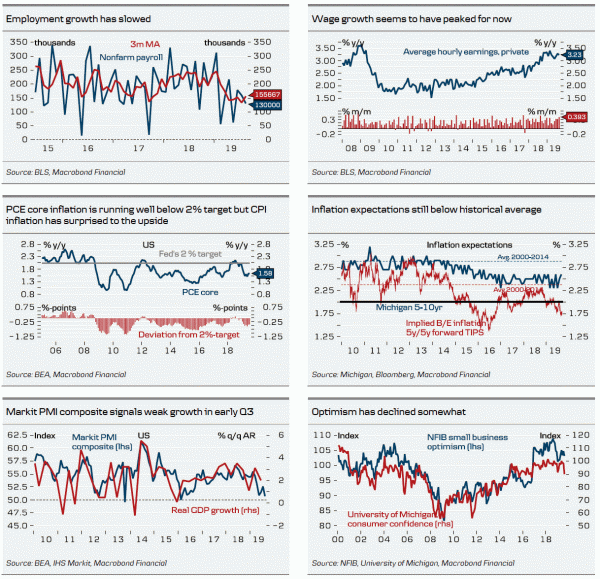Key takeaways
- We expect the Fed to cut again next week in line with market pricing.
- We expect the Fed to repeat its easing bias and to lower its dot plot to signal one more cut is on the cards but without a pre-commitment to this.
- If the Fed cuts next week, we still expect a 25bp cut at each of the next four meetings, taking the target range to 0.75-1.00% in March.
- We stick to our 1% target for US 10-year Treasury yields (see overleaf).
- We see a potential for the Fed to disappoint the market, which would weigh on EUR/USD. We still look for EUR/USD to trade close to 1.10 on 1-3M.
Things have worsened since the July cut
At next week’s FOMC meeting, we expect the Fed to cut its target range by a further 25bp. The three factors that explained the initial cut in July were (1) higher global political uncertainty, (2) slower global growth and (3) subdued inflation pressure.
Two out of three factors have worsened since July. Donald Trump escalated the trade war (although the tone has been more constructive recently) and data out of China and Europe have disappointed. US inflation has been stronger than expected over the past couple of months but inflation expectations have declined further. Focusing on US growth, both the ISM and PMI indicators show growth has peaked. This is particularly visible in the manufacturing sector, with the ISM manufacturing index now in recession territory. The service sector and private consumption remain robust but there are also signs service sector growth has slowed. There is always the risk that the downturn in manufacturing will spread to the service sector. Nonfarm payrolls have been on the weak side in recent months.
Prior to the Fed blackout period, which began on Saturday, we have heard from most FOMC members, including the most prominent ones. Fed Chair Jerome Powell has said that things have been ‘eventful’ since the July meeting and emphasised the easing bias that the Fed ‘will act appropriate[ly] to sustain the expansion’. This view has been echoed by both New York Fed President John Williams and Fed Vice Chair Richard Clarida in recent speeches. While FOMC members have not pre-committed to more cuts (see table on page 3), Powell did not rule out more easing coming. We would expect him to have done so if he had disagreed with current market pricing (25bp cut fully priced).
Esther George and Eric Rosengren have laid out the argument for dissenting again. James Bullard prefers a 50bp cut but, in our view, he will probably support the 25bp without dissenting. We do not expect the Fed to change much in the statement and believe it will repeat its easing bias (‘act as appropriate to sustain the expansion’). The dot plot will lower automatically, simply reflecting that the Fed will have cut twice since last time (assuming the September cut is a done deal). We think the Fed will signal that another cut may be on the cards this year, otherwise, in our view, it is a hawkish signal, compared with both our view and market pricing. The Fed has downplayed the importance of the dot plot.
We believe the downturn in the manufacturing sector will continue, supporting the case for further Fed easing. The macroeconomic outlook has become more uncertain. The cost of cutting the target range does not appear to be high due to low and stable inflation. If the Fed does not cut, the risk is that higher global trade uncertainty and slower global growth will trigger a slowdown in the US.
Besides a cut next week, we expect four more 25bp rate cuts, taking the target range to 0.75-1.00% at the March meeting next year (see Presentation – Five more cuts form the Fed (chart pack), 20 August). However, we stress that nothing in most recent Fed speeches indicates a larger cut of, for example, 50bp, which is normal outside recessions (we need to see more deterioration in [the labour market]).
Fixed income: expect little impact on US Treasuries
The fixed income market is more or less fully priced for a 25bp cut after the probability of a large 50bp cut has been almost fully priced out of the curve in September. Hence, we expect all market focus to be on the accompanying rhetoric. If Powell still talks about a medium-term adjustment, the recent move higher in yields could continue and the curve 2-10Y could start to flatten again. However, we strongly doubt we are in for a prolonged sell-off in US treasuries and, given our forecast for five more rates cuts including a September cut, we stick to our 1% target for 10Y US treasury yields. EUR/USD looking to repeat July FOMC price action
The market is priced for a 25bp, but is still expecting this to be followed by more rate cuts. If the Fed delivers a 25bp cut next week, the deciding factor will be the forward guidance on interest rates. Here we see a potential for the Fed to disappoint the market, which would weigh on EUR/USD. Price action in EUR/USD during the July FOMC meeting could provide a good blue print for what to expect from next week’s meeting. EUR/USD dropped some 50pips as Fed only cut 25bp and failed to pre-commit to further rate cuts. We would not be surprised to see a reaction of similar magnitude next week. In the medium term, we still expect Fed to eventually get ahead of the curve in terms of monetary easing and weaken USD and push EUR/USD higher. However, that is likely a story for next year. In the meantime, we look for EUR/USD to trade close to 1.10 on 1-3M.
















